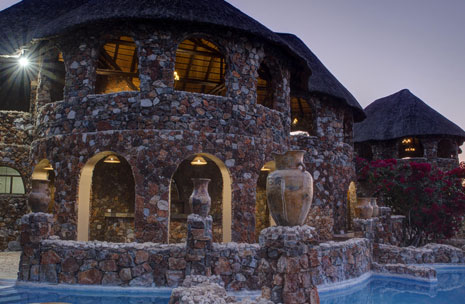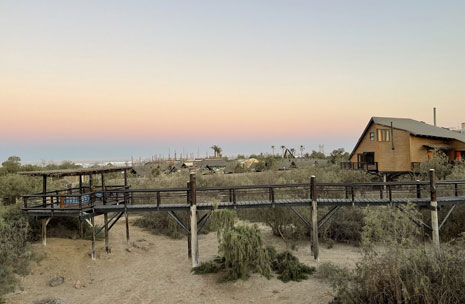Plains Camp honours the Hanssen’s family cattle-farming heritage with its three-tier accommodation facility of 10 spacious View Rooms, 14 spacious Standard Rooms and six affordable Garden Rooms.
It is family-friendly and wheelchair accessible.
The Plains Camp is 700m from the airstrip within the secluded wilderness area of Okonjima Nature Reserve and has majestic sunset views. Its design honours the Hanssen’s family cattle-farming history with its three-tier accommodation facility of 10 large View Rooms, 14 spacious Standard Rooms and six affordable Garden Rooms. It is family-friendly and wheelchair accessible. The Plains Camp Barn is an entertainment area and gathering place that includes:
- Dining and lounge area
- Wi-Fi facilities
- Cellphone reception
- Bar
- Swimming pool
- Curio shop
- Views over a waterhole and the Okonjima Plains
- Undercover Parking
Okonjima was a cattle farm since the early 1920s that was bought by Brahman breeders Val (VJ) and Rose Hanssen in 1970. By the time Namibia gained its independence in early 1990, they needed to address increasing livestock losses and growing interest in Namibia as a tourist destination. Three years later their herds of Brahman and Jersey cattle were sold and Okonjima’s attention turned to recovering the grass plains and transforming it into a nature reserve, with a primary focus on carnivore conservation through The AfriCat Foundation. Today it’s a luxurious African safari destination in the heart of Namibia that’s ideal for wildlife photography and famed for its cheetah, brown hyena and leopard sightings.
View Rooms
The 10 spacious View Rooms have earned their name for their views across the Okonjima grass plains.
All rooms are set 20-70 metres apart, some distance from the entertainment area at the Plains Camp Barn. Unit number one and the spacious family unit (a combination of rooms three and four) are closest to the barn.
Each View Room consists of:
- A large veranda with two day beds and two loungers
- A wheelchair ramp
- Two double beds
- Cellphone reception, a working desk and comfortable reading chair
- A tea/coffee station
- A mini fridge for own use
- Two roof fans
- Twin basins and a large twin shower
- A security safe,
- A telephone
- Private, undercover parking
Standard Rooms:
The 14 Standard Rooms also look out onto the Okonjima grass plains but are smaller in size than the View Rooms.Four of the rooms form two large family units. The family unit (rooms one and two) are closest to the barn, while the second family unit (rooms 13 and 14) are about 600m away.
The rooms are set 10-15 metres apart, some distance from the entertaining area at the barn.
Each Standard Room consists of:
- A small veranda with two directors chairs
- A wheelchair ramp
- Two double beds
- Cellphone reception, a table and two directors chairs
- A tea/coffee station
- A mini fridge for own use
- Two roof fans
- Twin basins and a large twin shower
- A security safe
- A telephone
- Private, undercover parking
The Okonjima Nature Reserve sprawls over 200 square kilometres of undulating plains, mountainous outcrops, and riverine thickets, and it is here that leopard (Panthera pardus), the most adaptable of all the wild cats, thrive. Read more about our Leopard Research.
These intelligent, solitary predators occur in high density in the expanse of Okonjima Nature Reserve’s multi-faceted topography. The Reserve’s predator research programme has spanned three decades, and its findings have provided great insight to leopard behavioral patterns as well as offered an upbeat prognosis for a sustainable future for the species in today’s Africa.
A two-day Okonjima stay offers the best chance to view wild leopard in Namibia, as well as those collared for research purposes, in their natural habitats. Research programme leopard are actively tracked, and their collars are an invaluable resource for locating, and then returning to the Reserve, cats which have migrated to surrounding farmland where they are perceived as threats to livestock.
The Okonjima Nature Reserve, a huge protected area set amongst the rugged commercial farmlands of central Namibia, comprises a diversified ecosystem representative of both the larger and small mammals of Namibia, as well as most of the country’s endemic birds.
Game drives and guided bush walks offer visitors an intimate, up-close perspective of Namibia’s wildlife and, especially, its most protected species.
The Okonjima Nature Reserve is home to and runs extensive research projects on rare and endangered species, big and small.













































